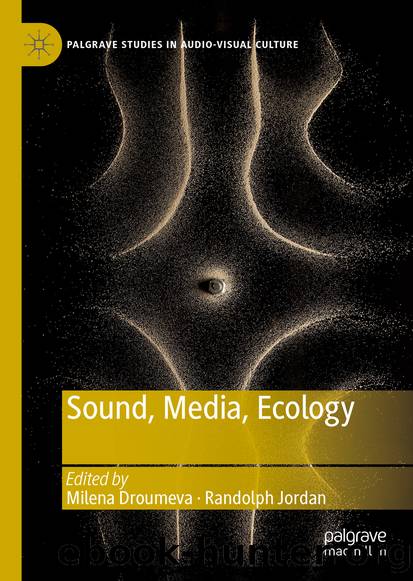Sound, Media, Ecology by Unknown

Author:Unknown
Language: eng
Format: epub
ISBN: 9783030165697
Publisher: Springer International Publishing
Latin American Modernity, Urban Informality, and the Making of Community
Conceptions of Western modernity have historically not been troubled by the inescapable global relationality that conditions theories of the Global South. This ambivalence is noteworthy, as scholars have repeatedly shown (Mintz, 1986; Trouillot, 1995; Williams, 1961), on account of how historically pivotal the Global South was (and remains still today) in the rise of Western dominance. This is particularly true of Latin America and the Caribbean which, through the exploitation of labour and resources, provided one of the main sources of European economic accumulation at the onset of early capitalism. In spite of how integral these geographies are to the history of Western modernity, conceptions of the historical epoch tend to characterize it as a moment of industrialization and urbanization alone. By contrast, Latin American and Caribbean modernity, although inclusive of industrialization and urbanization, consists primarily of European conquest and American expansionism. It is defined by the enactment of colonial power, the influence of which extends right up to the present day. The result is that prevailing conceptions of Latin American and Caribbean modernity describe it as an ongoing historical moment that is âcontradictoryâ and âhybridâ (GarcÃa Canclini, 1995), possessing a âdark sideâ (Mignolo, 2002) and âan articulation of many rationalitiesâ (Quijano, 2000).
The unequal conditions of Latin American and Caribbean modernity are made most tangible in urban centres across the region. Overpopulation, the growth of slum areas, a crisis in housing, infrastructural ruination, and the scarcity of basic necessities are only some of the struggles that residents face. The result is a form of urbanism that is itself, as GarcÃa Canclini describes, âcontradictoryâ and âhybridâ. On the one hand, there is the formal city which, as Fischer, McCann, and Auyero (2014) observe, âprofits economically and politically from the slumâs illegalityâ (p. 1). This city is governed by policy at both the municipal and state levels and is conditioned by a market to which most residents cannot gain uninterrupted access. On the other hand, there is the informal city, which âprovides a refuge from utopian urban regulations that would otherwise exclude many poor Latin Americans from city lifeâ (p. 1). Referring less to a particular spatial geography than to the ways that residents creatively resolve their most pressing needs, the informal city is animated by the collective energies of the cityâs marginal communities. Such practices are referred to as âinformal urbanismâ, which, urban studies scholar Rahul Mehrotra (2010) observes, is about âinvention within strong constraints with indigenous resources with the purpose of turning odds into a survival strategyâ (p. xiii).
Although informality is an important part of everyday life in cities across the region, it takes on a special quality in the city of Havana. Here, residents are known for their creative responses to the islandâs severely limited access to international capital on account of the U.S. embargo. Remittances from family and friends living abroad, alongside the slowly increasing potential for entrepreneurial activity, help support financial flows; however, they are generally insufficient, making the need to engage informal practices necessary for most residents.
Download
This site does not store any files on its server. We only index and link to content provided by other sites. Please contact the content providers to delete copyright contents if any and email us, we'll remove relevant links or contents immediately.
| Automotive | Engineering |
| Transportation |
Whiskies Galore by Ian Buxton(41725)
Introduction to Aircraft Design (Cambridge Aerospace Series) by John P. Fielding(33022)
Small Unmanned Fixed-wing Aircraft Design by Andrew J. Keane Andras Sobester James P. Scanlan & András Sóbester & James P. Scanlan(32690)
Craft Beer for the Homebrewer by Michael Agnew(18087)
Turbulence by E. J. Noyes(7901)
The Complete Stick Figure Physics Tutorials by Allen Sarah(7272)
Kaplan MCAT General Chemistry Review by Kaplan(6828)
The Thirst by Nesbo Jo(6768)
Bad Blood by John Carreyrou(6482)
Modelling of Convective Heat and Mass Transfer in Rotating Flows by Igor V. Shevchuk(6359)
Learning SQL by Alan Beaulieu(6165)
Weapons of Math Destruction by Cathy O'Neil(6090)
Man-made Catastrophes and Risk Information Concealment by Dmitry Chernov & Didier Sornette(5883)
Digital Minimalism by Cal Newport;(5593)
Life 3.0: Being Human in the Age of Artificial Intelligence by Tegmark Max(5410)
iGen by Jean M. Twenge(5333)
Secrets of Antigravity Propulsion: Tesla, UFOs, and Classified Aerospace Technology by Ph.D. Paul A. Laviolette(5244)
Design of Trajectory Optimization Approach for Space Maneuver Vehicle Skip Entry Problems by Runqi Chai & Al Savvaris & Antonios Tsourdos & Senchun Chai(4962)
Electronic Devices & Circuits by Jacob Millman & Christos C. Halkias(4871)
